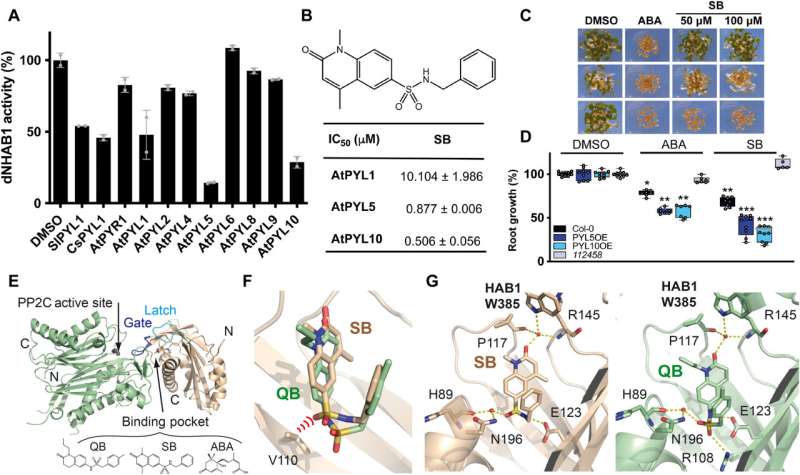Identification of SB as a selective ABA receptor agonist and structural analysis of the CsPYL1-SB-AtHAB1ΔN complex.(A) PP2C inhibition assay in the presence of 100 μM SB and the indicated ABA receptors. Values represent means ± SD of two assays. (B) Chemical structure of SB and half-maximal inhibitory concentrations (IC50) values for ABA- or SB-dependent inhibition of ΔNHAB1 by AtPYL1, AtPYL5, and AtPYL10. (C) Inhibition of seedling establishment by 1 μM ABA and 50 to 100 μM SB in WT Col-0 and either AtPYL5- or AtPYL10-overexpressing lines. Pictures were taken at day 4. (D) Quantification of ABA- or SB-mediated inhibition of root growth in the indicated genotypes. Seedlings were grown in plates supplemented with 0.5% dimethyl sulfoxide (DMSO) (mock), 50 μM SB, or 10 μM ABA. Values are means ± SD of three independent experiments (n = 13 to 16). Asterisks indicate statistical significance (*P < 0.05, **P < 0.01, and ***P < 0.001) in Student’s t test compared to its corresponding DMSO-treated line. (E) Ribbon representation of the overall CsPYL1-SB-AtHAB1ΔN ternary complex. Ligand (SB, QB, or ABA) binding in the ternary complex occurs in the closed conformation of the receptor that fits into the active site of the HAB1 phosphatase. (F) Superimposition of SB and QB in the ligand-binding site of CsPYL1. The steric hinderance between the oxygen of SB’s SO2 group and Val110 of CsPYL1 is represented as red arcs. (G) Detailed section of the SB (left) and QB (right) binding sites showing hydrogen bonding pattern of interactions between the ligand and CsPYL1:HAB1 complex. Credit: Science Advances (2023). DOI: 10.1126/sciadv.ade9948
Abscisic acid (ABA) is a plant hormone with essential functions in plant physiology. It is involved in developmental and growth processes and the adaptive stress response. Thus, the plant adaptation to stress situations caused by water deficit can be favored by activating this phytohormone pathway. In this project, the teams led by Pedro Luis Rodríguez at the IBMCP in Valencia and Armando Albert at the IQRF in Madrid developed a genetic-chemical method to activate this route in an inducible way and without penalizing plant growth.
Based on the atomic structure of the proteins involved and using genetic engineering techniques, CSIC researchers have created a modified ABA receptor activated by a mimetic molecule called iSB09. According to the results of their study, now published in the journal Science Advances, plants carrying this modified receptor and treated with iSB09 show high tolerance to drought.
"This combination efficiently activates the ABA pathway and generates protection by triggering the plant's adaptive mechanisms," says Pedro Luis Rodríguez from the IBMCP (CSIC-UPV). "Individually, the iSB09 molecule also reduces water loss by transpiration in tomato plants," he adds.
"This is the first time that an ABA receptor has been modified in crop plants to adapt it to a molecule mimicking the phytohormone," says Armando Albert from IQRF-CSIC. "This molecule is more persistent than the ABA hormone itself, which has a short half-life and can be added at the right time to protect the plant in drought situations," explains the CSIC researcher.
Drugs against drought. Credit: UPV
According to the study, this combination makes it possible to reduce the dose of agrochemicals used on crop plants because the mix with the modified receptor enhances the effect of the molecule. "We aim to improve the plant's resistance to drought and even, in extreme cases, to allow them to survive until irrigation is restored," reveals Pedro Luis Rodríguez. "The aim is to develop drugs against drought by applying the advanced molecular knowledge developed in the plant world," he says.
To carry out this work, the CSIC researchers have used strategies previously applied in the biomedicine field (known as 'drug discovery'), but in this case, transferred to agricultural biotechnology. The method has been protected by a CSIC-UPV patent, as the Institute of Molecular and Cellular Biology of Plants is a joint center.
According to the researchers, "The iSB09 molecule will have to pass food safety studies like any other agrochemical, something that the company that exploits this molecule will be in charge of. The introduction of the modified receptor, like all genetic modification, is pending changes in European legislation, for example, the acceptance of the CRISPR technique in agricultural biotechnology. But companies can use this approach in other countries where it is allowed."
More information: Jorge Lozano-Juste et al, Structure-guided engineering of a receptor-agonist pair for inducible activation of the ABA adaptive response to drought, Science Advances (2023). DOI: 10.1126/sciadv.ade9948. www.science.org/doi/10.1126/sciadv.ade9948
Journal information: Science Advances
Provided by Universitat Politècnica de València
























